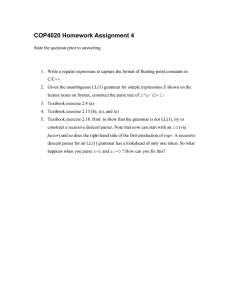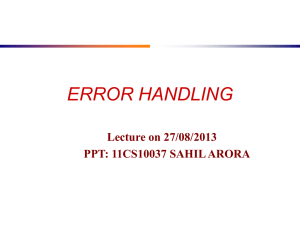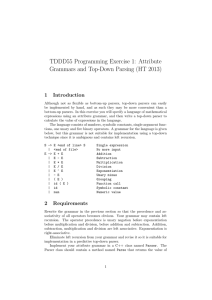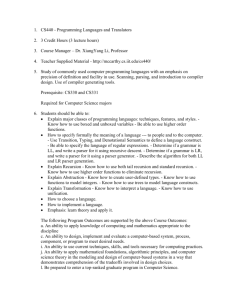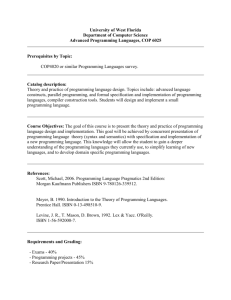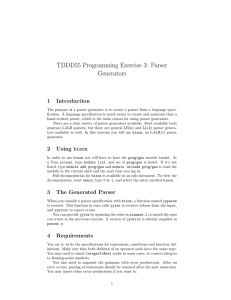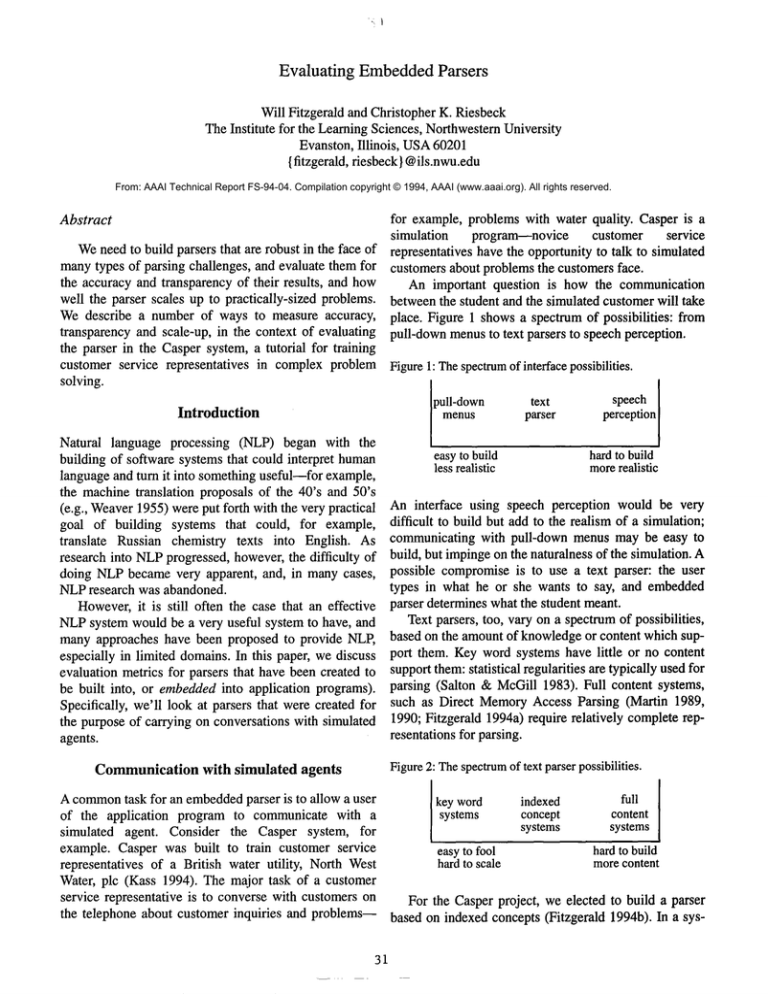
Evaluating EmbeddedParsers
Will Fitzgerald and Christopher K. Riesbeck
The Institute for the LearningSciences, NorthwesternUniversity
Evanston, Illinois, USA60201
{ fitzgerald, riesbeck } @ils.nwu.edu
From: AAAI Technical Report FS-94-04. Compilation copyright © 1994, AAAI (www.aaai.org). All rights reserved.
for example, problems with water quality. Casper is a
simulation
program--novice
customer service
Weneed to build parsers that are robust in the face of representatives have the opportunity to talk to simulated
manytypes of parsing challenges, and evaluate them for customers about problemsthe customers face.
the accuracy and transparency of their results, and how
An important question is how the communication
well the parser scales up to practically-sized problems. betweenthe student and the simulated customerwill take
Wedescribe a number of ways to measure accuracy,
place. Figure 1 shows a spectrum of possibilities: from
transparency and scale-up, in the context of evaluating pull-downmenusto text parsers to speech perception.
the parser in the Casper system, a tutorial for training
customer service representatives in complex problem Figure1: Thespectrumof interfacepossibilities.
solving.
speech
text
pull-down
Introduction
menus
parser
perception
Abstract
Natural language processing (NLP) began with the
building of software systems that could interpret human
languageand turn it into somethinguseful--for example,
the machine translation proposals of the 40’s and 50’s
(e.g., Weaver1955) were put forth with the very practical
goal of building systems that could, for example,
translate Russian chemistry texts into English. As
research into NLPprogressed, however, the difficulty of
doing NLPbecame very apparent, and, in many cases,
NLPresearch was abandoned.
However,it is still often the case that an effective
NLPsystem would be a very useful system to have, and
many approaches have been proposed to provide NLP,
especially in limited domains. In this paper, wediscuss
evaluation metrics for parsers that have been created to
be built into, or embeddedinto application programs).
Specifically, we’ll look at parsers that were created for
the purpose of carrying on conversations with simulated
agents.
I
easy to build
less realistic
hardto build
morerealistic
An interface using speech perception would be very
difficult to build but add to the realism of a simulation;
communicating with pull-down menus may be easy to
build, but impingeon the naturalness of the simulation. A
possible compromiseis to use a text parser: the user
types in what he or she wants to say, and embedded
parser determines what the student meant.
Text parsers, too, vary on a spectrumof possibilities,
based on the amountof knowledgeor content which support them. Key word systems have little or no content
supportthem:statistical regularities are typically used for
parsing (Salton & McGill 1983). Full content systems,
such as Direct MemoryAccess Parsing (Martin 1989,
1990; Fitzgerald 1994a) require relatively complete representations for parsing.
Figure2: Thespectrumof text parserpossibilities.
Communication with simulated agents
full
A common
task for an embeddedparser is to allow a user
key word
indexed
systems
concept
content
of the application program to communicate with a
systems
systems
simulated agent. Consider the Casper system, for
example. Casper was built to train customer service
easy to fool
hard to build
hard to scale
more content
representatives of a British water utility, North West
Water, plc (Kass 1994). The major task of a customer
service representative is to converse with customers on
For the Casper project, we elected to build a parser
the telephone about customer inquiries and problems-- based on indexed concepts (Fitzgerald 1994b). In sys31
tern using indexed concept parsing, each potential parse set of possible responses. Thesystemis built to turn that
is tagged with sets of index concepts. Index concepts can text into a representationor set of representationsthat the
be arranged in a taxonomichierarchy; each index concept system can use to makethe appropriate responses.
In the case of the Caspertutor, a user mightbe in the
is tagged with phrasal patterns. For example, the index
concept Water-Bits
might be tagged with the phrasal situation of troubleshooting a (simulated) customer’s
patterns "bits" or "particles." Reading"bits" in the input water quality problem, specifically (for example)trying
sentence "Canyou describe what the bits look like?" will to determine exactly what the problem is that the cusactivate the Water-Bits index concept. Activating an tomer is experiencing. Amongthe tutor’s possible
index concept meansthat it will provide positive evi- responses is to intervene if the student is asking leading
dence for each potential parse with which it has been questions (for example, "Doyou have black bits in the
tagged, and negative evidence for each potential parse water?") and tell the student to ask non-leadingquestions
with whichit is not been tagged. Hierarchical relation- ("Can you describe the water to me?"). Amongthe repreships between index concepts are honored, as well: If sentations that the parser mightproduceare the representations for the questions "Doyou have black bits in the
Water-Bitsare an instanceof Water-QualityProblem,
thenactivating
alsoWater-Bits
activateswater?" and "Can you describe the water to me?"
So, given this modelof embeddedparsing, to evaluate
Water-Qual i ty- Problem.
The advantage of indexed concept parsing is that a parser embeddedin an application program, we want to
going about the task of creating content to support an ask:
embeddedparser is simplified--the index concepts have ¯ Does the parser produce the right representations?
Thatis, is the parser accurate?
no structure (in the limit), nor do the phrasal patterns
¯ Does the parser promote the sense that a conversaassociated with them(in the limit).
tion is taking place? That is, is the parser transparent?
In building a new technology, we want to answer the
¯
Is the parser capable of adequately handling the variquestion, Does the technology work? Does it do what it
eties of texts, users, situations and possible responses
was built to do? Before we can measure this, however,
it mightmeet?That is, is the parser scalable?
we need to understand exactly what a parser is built to
do.
Measuring Accuracy
A model of embedded parsing
To measure the accuracy of a parser presumes we know
In Casper, a novice customerservice representative will the answerto the question, what has the parser been built
communicatewith simulated customers. As the student for? For example,parsers built as general, off the shelf
system (Alshawi et al 1992)
communicates,a tutorial system intervenes. As with any tools such as the CLARE
the
Alvey
NL
Tools
(Briscoe,
et al. 1987), might define
such program, the numberof interventions is limited-the tutor will be built to respondin certain situations, but accuracy as coverage: that is, how muchof naturally
not in others. So, a key feature of such systems is that occurring language the parser is likely to be able to
there is a limited (even if large) numberof responses the process. A typical statement of coverage, perhaps, comes
system can process. In general, we can build a model of from a description of the natural language processing
system in the Cyc project: "The Syntax module can
an embeddedparser (Figure 3 shows a diagram).
properly handle about 75%of the sentences found in the
Figure 3: Modelof an embedded
parser
news stories of a typical issue of the newspaper USA
Today... by ’properly’ here wemeanthat the output is as
System
good as what our knowledgeentered independently come
[
]lResponso---I~ up with." (Guha and Lenat 1994, p. 138), and from
I ...-.----. 4Representation
.....
~1.tuat~°n ~’Parser~_-CRepresentation~Response---I~ description of the Alvey NLTools: its grammaris "in
altuatlon----I~Ik..____.J
k,~
principle able to analyse 96.8%of a corpus of 10,000
I\’Response----I~
Situation
[_~ ~Representation
]%esponse---’llP noun phrases taken from a variety of corpora (Carroll
1994, footnote 2)." Parsers might be built for more
Text t
immediate tasks, such as text categorization
or
information extraction. For example, the Message
Student
Understanding Conferences (MUC)bring together
variety of research systemsto comparetheir abilities to
An embeddedparser is built to transform text that a user read articles (for example,about terrorist episodes) and
enters in a particular situation, for whichthe systemhas a fill in a template about the article, for example,whowere
32
the victims, the perpretrators, etc. (Jacobs and Rau1993;
Soderland and Lehnert 1994).
But our task is not syntactic coverage, information
extraction or text categorization. Rather, weare describing parsers embeddedinto application programs. Fig. 1
describes a modelof such a parser. There are three inputs
to a parser: a text, a user anda situation. Theoutputof the
parser should be a set of representations that accurately
model the intentions of the user in the situation, as
expressed by the text.
To measure the accuracy of a parser, we assume the
existence of an oracle that can return just those representations that do accurately modelthe intentions of the user
in a situation as expressed by the text--assuming the representations exist that do so modelthe user’s intentions.
If we have such an oracle, we can comparethe output of
the parser with the output of the oracle. Wewill call the
representations that an oracle would produce oracular
representations, and the representations producedby the
parser, parsed-to representations. Let us call a representation that is both a parsed-to representation and an oracular representation a relevant representation.
Recall and Precision
Wheredoes the oracle come from?
An important question to ask is where the oracle comes
from. Becausethe oracle is an idealized construct, wecan
only approximate one. One approach is to avoid
approximating the oracle altogether,
and to use
information theoretic measuresof the effect of different
information sources on the probability that a given
hypothesis, re O, is true (for example, Rosenfeld
1994). Another approach, exemplified by the MUC
evaluations, is to approximatethe oracle by enumerating
the correct answers for a given sample of inputs, and
assumethat these results project to the general population
of inputs (Jacobs and Ran1993). This is the approachwe
will take in this work.
Perfect andacceptable recall
In the model of embedded parsing given above, the
output of the parser is a representation or set of
representations. It maybe that, for the purposes of the
application program, it would be acceptable for an
oracular representation to appear within a set of
representations, of a certain size. For example, in the
Casper system, the student can pick from the top seven
best results of the parser. As long as the oracular
representation is within the top n results, wecan call it a
relevant representation. Figure 4 showsthe results from
the Casper parser from the text, "Describe the particles,
please." The oracular match, "Whatkind of bits are in
you water?" is shownin bold face. Becausethis sentence
appears in the top 7 results, wecall this an acceptable
match; because it is also the best matchreturned by the
parser, wesay it is a perfect match.
There are a variety of ways of comparingthe output of
the oracle and the output of the parser. Twoof the most
commonlyused are recall and precision (Salton and
McGill 1983; Jacobs and Rau 1993; Soderland and
Lehnert 1994). Recall is the ratio of relevant
representations to oracular representations. Wewant
parsers that have high recall--this meansthat the parser
produces the representations that the idealized oracle
produces (although it may also produce other
representations that the oracle wouldn’t). In equation
Figure4: Resultsfromparsing"Describethe particles, please"
form:
le ol
Iol
Parse:[ Describethe particles, please
(EQ1)
whereP is the set of parsed-to representations and 0 is
the set of oracular representations.
Ideally, wewant the parser to producejust those representations that the oracle wouldproduce. Precision is a
measureof this: it is the ratio of relevant representations
to all of the representations producedby the parser. In
equation form:
]
Results:
Whatkind of bits are in yourwater?
Canyou describe the problem?
Canyou drawsomewater and tell mehowit smells?
Canyou drawsomewater and tell mehowit tastes?
Canyou drawsomewater and tell mehowit looks?
Canyourun the water andtell mewhatyou see?
Canyou run the cold tap andtell mewhatyou see?
Withthese definitions in mind, wecan also define perfect
recall and acceptable recall. Perfect recall is the recall
I/’1
ratio whenwedescribe a representation as relevant if it is
again, whereP is the set of parsed-to representations and the best (or only) match produced by the parser.
Ois the set of oracular representations.
Acceptable recall is the recall ratio when the
IPmOI
(EQ2)
33
3.-.
representationis relevant as long as it appearsin the top n Measuringnegotiation
matchesproduced by the parser.
It is often the case that an interactive programwill allow
the
user to committo or to reject the results of a parse,
Measuring transparency
and, if the user rejects the parse, to try again to produce
Recall and precision are measures of the accuracy of a an acceptable parse. This is analogous to a human
parser. Wewouldalso like to measure howtransparent a conversation, in whichone person says something, call it
parser is. Following Heidegger, Winogradand Flores A, and the other person asks whetherby Athe first person
(1987) discuss the readiness to hand of tools. A tool is meantB (a paraphrase of A). The first person can agree,
ready to handif it becomestransparent in its use. That is, or try again. We’ll assumethat the fewer numberof turns
we don’t notice a hammerwhen we’re pounding a nail the user needs to negotiate the meaningof the user’s
because we focus on the goal of getting the nail in the input, the moretransparent the parser will be. Measuring
wood.If the hammeringfails, we might then examinethe the howlong it takes on average to cometo an agreement
hammer--perhapsthe flat end has becomeworn, or there we’ll call negotiationlength.
is some other problem. The hammerbecomes unready to
Wehave developed two measurementsof negotiation,
hand; while examining it, we cannot be pounding. both of which makeuse of the student’s being able to
Similarly, a parser is ready to hand, or transparent, when makemultiple attempts before committing to a result.
the user of the parser does not have to wonderabout the Oneimportant fact is that a student must (unless he or
tool and its workings, but can concentrate on achieving she gives up on the entire tutorial) committo someresult
the communicategoals he or she has. Twocharacteristics
at some time. The first measurementwe call the first
of a parser that will affect transparencyare time to parse strike percentage. This measuresthe percentage of times
and number of negotiations
required.
These
the parser returns a result that is accepted by the user on
characteristics are defined below.
the first attempt. We can also measure how many
attempts it takes for a student to reach a result, and take
Measuring speed
the averagethis over all the attempts. This we’ll call the
averagepath length; the closer the average path length is
Accuracy measurementsaffect transparency, but there
to 1.0, the moretransparent it is (an interface with a first
are manydifferent reasons that a parser could become
strike rate of 100%wouldhave an average path length of
non-transparent. A parser will tend to become less
1.o).
transparent as the time it takes to return its results
increases. The amountof time it takes for a parser to
Measuring scale-up
return its results for a specific interaction wewill call the
time to parse.
One of the most important questions to ask of any
In the natural languageparsing literature, time to parse parsing technology, especially ones built on concepts and
are typically measuredin one of two ways. In the first techniques in artificial intelligence, is whetherit will
way, the algorithmic computational complexity of the scale up to large problems(Schank1991). Previously,
parsing algorithms used are examined. The advantage of described a spectrum of text parsers, from key word
this approach is that a theoretical upper bound on the parsers, to indexed concept parsers, to full content
parse time can be given. Unfortunately, most parsing parsers. Keyword systemstend to fail as they are scaled
algorithms have upper boundsthat are cubic to the length up to large problemsbecausethey rely on the statistical
of the input string (that is, an estimate of howlong it will correlation of text to underlying meaning.Factors such as
take to parse a sentence of n words will be dominatedby synonymyand ambiguity tend to lower the correlation.
somefunction of n3). Empirically, though, parsers tend to Full content parsers, on the other hand, tend to fail as
do muchbetter than this, and so even researchers whoare they are scaled up becausethey are difficult to build; the
of a theoretical bent are proposing empirical testing of underlying conceptual representations required can be
different parsers (Slocum 1981, Carroll 1994). For arbitrarily hard.
parsers in interactive programs,perhaps the best measure
Our hope, as we developed an indexed concept parser
of parse time is perceived average wall time: that is,
for the Casper project, was that indexed concept parsing
asking the users of the system whether, on average, the would provide most of the advantages of both key word
parser wasfast enoughin returning its results.
systemsand full content parsers, that is, by creating minimalist representations, we could solve (some of) the
problems key word systems have with synonymy and
ambiguity without having to create large numbers of
34
articulated representations required to do full content
parsing.
By creating an index concept parser, we wanted to
build a parser that would scale up. But the question
remains, howwould we measure this?
Wehave hinted that there are two concerns related to
scale up. One concern is with the development cost of
scaling up: is it possible to create the representations
need to support parsing? The other concern is with the
complexityof the representations of the application program. Assumingthat representations can be built for
parsing, howwell will the parser behave(for example,on
recall measures) as the underlying complexityincreases?
Practically, though, we only need measure scale-up
for a particular implementationof a parser in an application program.In this case, the complexityof the underlying representations is known.In terms of the model of
embeddedparsing given before, we know the range of
situations and responses whichthe parser will encounter
(although we probably do not knowthe range of texts
and users the parser will encounter).
Then, measuring scale-up becomes a qualitative
answer to the following questions:
¯ Is the cost of creating the parser acceptable?
¯ Is recall acceptable for the entire range of situations
and possible responses?
Our suspicions are that key word systems will have
acceptable developmentcosts but low recall for medium
to large (open-ended)systems; that full content parsers
will have high developmentcosts but low recall for small
to medium size systems, and impossibly high
developmentcosts for large systems; and that indexed
concept parsing will have acceptable costs and recall
rates for small to mediumsystems, but unacceptable
recall rates for large systems.
cepts, representations of different ways to achieve the
same communicate,goal and handling anaphora.
TABLE
1. Accuracymeasuresin Casper(recall)
Accuracymeasures(N=391)
i
Percentageof acceptablematches 329
(set size = 7; best=100%)
Percentageof perfect matches
273
%
84.1%
69.8%
Table 2 showstransparency measures. The first strike
rate for the parser, evenin the strict version of this, was
higher than the menus, and the average path length was
longer--both giving evidence that the type-in box with
the parser is preferable to the hierarchical menus.
TABLE
2. Transparency
measuresin Casper(strike
rate)
Strikerate
First strike rate, hierarchical
menus(best=100%)
Loosefirst strike rate, parser
Strictfirst strike rate, parser
n
260
i
%
179 68.8%
391
322
82.4%
391 270 69.1%
Table 3 shows average path length measures. It is
interesting to comparethe frequency with which the
parser and the hierarchical menuswere used on the first
attempt: manymore interactions were started with the
parser than the menus(391 and 260, respectively); this
concurs with user reports that they preferred to use the
parser. Theaveragepath length for the parser is less than
the average path length of the hierarchical menus. This
indicates that the students were able to say what they
wantedto say in fewer tries using the parser.
TABLE
3. Pathlength measuresin Casper(path length)
Evaluation of the Casper parser
Having mentioned these measurementsin the context of
Casper, wenowdescribe the actual results of using some
of these measureson the use of the parser in Casper. The
following tables showthe results of the beta testing of
Casper on 12 customer service representative trainees
who were engaged in up to six conversations with
simulated customers.
Table 1 shows relevance measures. The percentage of
acceptable matches was 84.1% in the beta testing. We
hope to use the results of the beta testing to improvethe
parser, particularly in adding synonymsfor indexed con-
35
Averagepath length
o26 n length
Averagepath length, hierarchical menus
1.75
(best=l.00)
Averagepath length, parser
391 1.28
Conclusions
Historically, parsers have been created to prove some
theoretical point. But building parsers for practical
applications will affect howwe evaluate them. Weneed
to build parsers that are robust in the face of manytypes
of parsing challenges, and evaluate them for their
accuracy and transparency, and howwell they scale up
for practical systems.
Acknowledgments
This work was supported in part by the Defense
Advanced Research Projects Agency, monitored by the
Office of Naval Research under contracts N00014-91-J4092 and N00014-90-J-4117. The Institute
for the
Learning Sciences was established in 1989 with the
support of Andersen Consulting, part of The Arthur
AndersenWorldwideOrganization. The Institute receives
additional support from Ameritech and North West Water
Groupplc, Institute Partners, and from IBM.
References
Alshawi, H., Carter, D., Crouch, R., Pulman,S., Rayner,
M. & Smith, A. (1992). CLARE:A Contextual Reasoning and Cooperative Response Frameworkfor the
Core Language Engine. Cambridge, UK: SRI International.
Briscoe, E., Grover, C., Boguraev, B. & Carroll, J.
(1987). A formalism and environment for the developmentof a large grammarof English. In Proceedings
of 10th International Joint Conferenceon Artificial
Intelligence, (pp. 703-708).
Carroll, J. (1994). Relating complexityto practical performance in parsing with wide-coverage unification
grammars.In the Proceedings of the Association for
ComputationalLinguistics, (to appear).
Fitzgerald, W. (1994a). Direct memoryaccess parsing
the Creanimate biology tutor. In Proceedings of the
Tenth Conferenceon Artificial Intelligence for Applications, (pp. 467-468). Los Alamitos, CA: IEEE
ComputerSociety Press.
Fitzgerald, W. (1994b). Indexed concept parsing for
interactive tutors. Proceedingsof the Active Natural
Language Workshop of the AAAI Spring Symposium
1994.
Guha, R. V. & Lenat, D. B. (1994). Enabling agents
work together. Communicationsof the ACM,37(7),
127-142.
Jacobs, P. S. & Rau, L. E (1993). Innovations in text
interpretation. Artificial Intelligence, 63(1), 143-191.
Kass, A, (1994). The Casper Project: Integrating simulation, case presentation, and Socratic tutoring to teach
diagnostic problem solving in complex domains.
Technical Report 51. The Institute for the Learning
Sciences, NorthwesternUniversity, Evanston, IL.
Martin, C. E. (1989). Case-based parsing and MicroDMAP.In Inside Case-based Reasoning, C.K. Riesbeck and R. C. Schank, eds. (pp. 319-392). Lawrence
ErlbaumAssociates, Hillsdale, N.J.
Martin, C. E. (1990). Direct MemoryAccess Parsing.
Ph.D. dissertation, Yale University, NewHaven, CT.
36
Rosenfeld, R. Adaptive Statistical LanguageModeling:A
MaximumEntropy Approach. Technical Report
CMU-CS-94-138,
Carnegie Mellon University, Pittsburgh, PA.
Salton, G. & McGill, M. J. (1983). Introduction to Modern Information Retrieval. McGraw-Hill.
Schank, R. (1991). Where’s the AI? AI Magazine, 12:4,
pp. 38-49.
Slocum, J. (1982). A practical comparison of parsing
strategies. In Proceedingsof Proceedingsof the 19th
Annual Meeting of the Association for Computational
Linguistics, (pp. 1-6).
Soderland, S. & Lehnert, W. (1994). Corpus-driven
knowledgeacquisition for discourse analysis. In the
Proceedings of the Twelfth National Conference on
Artificial Intelligence, (to appear).
Weaver,W. (1955). Translation. In W. N. Locke & A.
Booth (Eds.), MachineTranslation of Languages(pp.
15-23). London:John Wiley and Sons.
Winograd,T., & Flores, F. (1987). Understanding Computers and Cognition: A NewFoundation for Design.
Reading, MA:Addison-Wesley.

